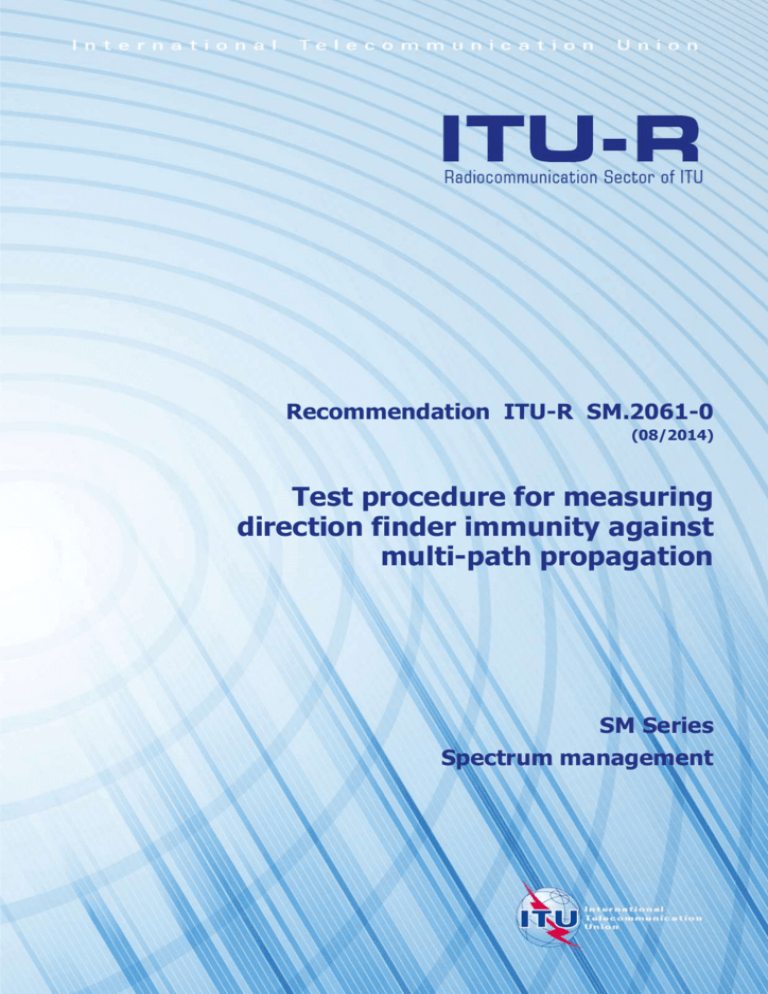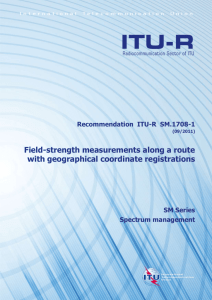
Recommendation ITU-R SM.2061-0
(08/2014)
Test procedure for measuring
direction finder immunity against
multi-path propagation
SM Series
Spectrum management
ii
Rec. ITU-R SM.2061-0
Foreword
The role of the Radiocommunication Sector is to ensure the rational, equitable, efficient and economical use of the radiofrequency spectrum by all radiocommunication services, including satellite services, and carry out studies without limit
of frequency range on the basis of which Recommendations are adopted.
The regulatory and policy functions of the Radiocommunication Sector are performed by World and Regional
Radiocommunication Conferences and Radiocommunication Assemblies supported by Study Groups.
Policy on Intellectual Property Right (IPR)
ITU-R policy on IPR is described in the Common Patent Policy for ITU-T/ITU-R/ISO/IEC referenced in Annex 1 of
Resolution ITU-R 1. Forms to be used for the submission of patent statements and licensing declarations by patent holders
are available from http://www.itu.int/ITU-R/go/patents/en where the Guidelines for Implementation of the Common
Patent Policy for ITU-T/ITU-R/ISO/IEC and the ITU-R patent information database can also be found.
Series of ITU-R Recommendations
(Also available online at http://www.itu.int/publ/R-REC/en)
Title
Series
BO
BR
BS
BT
F
M
P
RA
RS
S
SA
SF
SM
SNG
TF
V
Satellite delivery
Recording for production, archival and play-out; film for television
Broadcasting service (sound)
Broadcasting service (television)
Fixed service
Mobile, radiodetermination, amateur and related satellite services
Radiowave propagation
Radio astronomy
Remote sensing systems
Fixed-satellite service
Space applications and meteorology
Frequency sharing and coordination between fixed-satellite and fixed service systems
Spectrum management
Satellite news gathering
Time signals and frequency standards emissions
Vocabulary and related subjects
Note: This ITU-R Recommendation was approved in English under the procedure detailed in Resolution ITU -R 1.
Electronic Publication
Geneva, 2014
ITU 2014
All rights reserved. No part of this publication may be reproduced, by any means whatsoever, without written permission of ITU.
Rec. ITU-R SM.2061-0
1
RECOMMENDATION ITU-R SM.2061-0*
Test procedure for measuring direction finder immunity
against multi-path propagation
(2014)
Scope
The Recommendation provides test procedures for measuring the immunity against multi-path propagation of
fixed and mobile direction finders (DF).
Keywords
DF, direction finder, test procedure, immunity, multi-path propagation, reflections, open-air-test-site,
OATS
Related ITU Recommendations, Reports
Recommendation ITU-R SM.2060.
Report ITU-R SM.2354.
NOTE – In every case the latest edition of the Recommendation/Report in force should be used.
The ITU Radiocommunication Assembly,
considering
a)
that ITU-R has published the direction finder (DF) immunity against distorted wave fronts
of different DF methods in the ITU Handbook on Spectrum Monitoring (Edition 2011);
b)
that the immunity against distorted wave fronts is an important specification of a DF since
distorted wave fronts from multipath propagation are typical in practice;
c)
that the specification of DF immunity against distorted wave fronts strongly depends on the
test procedures applied;
d)
that a test procedure for DF immunity against distorted wave fronts must be independent of
the direction finder design;
e)
that well-defined test procedures for DF immunity against distorted wave fronts to test the
influence of multi-path propagation under approximated real-world conditions, if adopted by all
manufacturers of direction finders intended for civil radio monitoring, will have the advantage for the
users of such direction finders, that an easier and more objective assessment of products from different
manufacturers is possible,
recommends
1
that the measurement method in Annex 1 should be used to determine and report the
immunity against distorted wave fronts due to multi-path propagation on fixed and mobile directionfinding systems.
*
Radiocommunication Study Group 1 made editorial amendments to this Recommendation in 2015 in
accordance with Resolution ITU-R 1.
2
Rec. ITU-R SM.2061-0
Annex 1
Immunity against distorted wave fronts due to multi-path propagation:
test procedure for fixed and mobile direction finder
1
General considerations
Under normal circumstances, wave propagation between the emitter and DF is disrupted by buildings,
mountains, hills, etc. Even if we have direct line of sight, secondary waves will still arise due to
reflection, refraction and diffraction and superimpose the direct wave at the receiving location as
interfering fields. If the interfering wave component has a lower power level than the desired wave
component, the bearing error can be minimized by choosing suitable design parameters in the
direction finder. This Recommendation serves to measure the DF immunity to distorted wave fronts
caused by a secondary wave (reflection). It is meant to be used for an exemplary measurement of one
single sample of the serial production version of the DF system under test.
2
Principle of measurement
The measurement will be conducted under simplified conditions, thus permitting great simplicity of
the tests and easy repeatability of the results at any time and at any site. In order to simulate a
multipath environment, an arrangement of two transmitting antennas (two-wave field produced by a
single transmitter) is proposed subsequently. Both antennas are connected to the test transmitter via
a power divider. By using an attenuator, the amplitude of the signal which represents the reflection
(secondary wave) can be set, and hence determine the amplitude relation between direct (primary)
and reflecting (secondary) path. The angle of arrival and the phase angle of the secondary wave is
varied. Considering the objective to simplify the measurement, effects of modulation type (including
phase and time variant signals), signal duty cycle, bandwidth, signal polarization, and signal duration,
noise and other signal and DF quality parameters (e.g. DF sensitivity) are intentionally ignored to
reduce the complexity of the tests procedure and the time duration of the measurements. The
measurement takes place in an otherwise reflection-free environment such as an open-air-test-site
(OATS) or an anechoic chamber.1
In addition to the recommended measurement procedure described here, it is possible to measure the
DF immunity against distorted wave fronts by means of multi-channel emulators which can simulate
the propagation effects of a real environment, in situations where an OATS or anechoic chamber is
not readily available.
3
Measurement set up
The proposed measurement setup is shown in Fig. 1. In order to ensure a well-defined dual-path
propagation scenario, the environment of the DF and transmitting antennas should be free of
reflecting obstacles and interferences as indicated in Recommendation ITU-R SM.2060-0. The
distances between the DF antenna and both transmitting antennas, as well as the height of all antennas
involved should be in line with Recommendation ITU-R SM.2060-0.
1
OATS definition can be found in a number of standards documents such as ANSI C63.7, CISPR or
EN55 022. The OATS is considered as line-of sight with no interference signal, no reflection and far-field
(Fraunhofer Region).
Rec. ITU-R SM.2061-0
4
3
Measurement procedure
In order to simulate a basic multipath wave environment (two-wave field produced by a single
transmitter), an experimental test bed as shown in Fig. 1 is recommended:
–
an un-modulated continuous wave input signal S on various measurement frequencies within
the operational frequency range of the DF is generated using a signal generator;
–
the input signal S is divided into S1 and S2 signals by means of a power divider;
–
the S1 signal is transmitted by transmit antenna 1; and
–
attenuation and phase shift is added to the S2 signal before it is transmitted by transmit
antenna 2 from a different angle than S1.
Both S1 and S2 signals must have a power level high enough to ensure a minimum S/N of 20 dB (in
order to ensure that system noise does not affect the measurement results).
Due to the fact that the DF immunity to distorted wave fronts tends to vary with frequency it is
required to repeat the measurement for various measurement frequencies. The measurement
frequencies are selected in line with Recommendation ITU-R SM.2060-0.
For each measurement frequency, the S2 signal from antenna A2 (the “reflected” signal) is varied in
azimuth, amplitude and phase shift as follows:
–
the angle of arrival difference between the reflected wave S2 and the main wave S1 is set
to 20°, 60° and 90°;
–
the amplitude ratio of the reflected wave S2 and the main wave S1 is set so that the power
level of S2 is 0.25 (−6 dB) with respect to S1 at the DF antenna. Note that takes into account
all gains and losses over cables, antennas and air;
–
the positive time delay difference of the reflected wave S2 is set so that a phase difference
of 0°±5°, 90°±5° and 200°±5° between S1 and S2 occurs at the DF antenna. Note that
takes into account all propagation delays over cables, antennas and air. Note further that the
phase shift can be applied by a variable phase shifter or a delay line, besides ±5° have been
included to consider uncertainties of the setup configuration, e.g. small variations of the
antenna locations during placement.
For all different settings described above, the bearing error is measured and the RMS bearing error is
calculated with the formula stated in Recommendation ITU-R SM.2060-0, resulting in one RMS
bearing error per measurement frequency. The final result is presented as a table or chart indicating
the RMS bearing error for each measurement frequency as indicated in Table 1.
It should be noted that the recommended measurement procedure is focused on a single angle of
arrival of the primary wave. However, it would be desired in specific cases that different angles of
arrival of the primary wave are measured by rotating the antenna. If such specific test conditions are
applied, this should be indicated in the test reports.
4
Rec. ITU-R SM.2061-0
FIGURE 1
Measurement setup for determining the direction finder immunity to distorted wave fronts
Main signal
Transmit
antenna A1
for main wave
Clear test area
: Variable angle
Main
wave
S1(t)
w av e
R ef lecte d
)
. S1 ( t-
S2 (t) =
Reflected
signal
A2
it anten na
T rans m
ve
wa
d
cte
f or re fle
: Variable
delay shifter
Angle
resolution
DF antenna
in the
direction
of A1
Q3 dB
DF
Antenna
: Variable
attenuator
Controller
DF processor
Power divider
Input signal S (t )
Common test
transmitter
SM.2061-01
TABLE 1
Sample test data table
[Signal modulation:_____________Signal polarization: _______ S2 relative power level at the DF antenna: __ (dB)
True
Index
Azimuth
1
0°
20°
Frequency 2
Frequency 3
Frequency M
DF
DF
DF
DF
…
…
…
…
…
…
…
…
0°
2
90°
3
200°
60°
Frequency 1
0°
90°
200°
90°
0°
90°
200°
…
…
…
…
Note that is the difference between the true azimuth (angle of the transmitter’s test antenna) and
the displayed bearing on the DF equipment.
Example for a specification in a data sheet of DF immunity against multi-path propagation conditions:
Rec. ITU-R SM.2061-0
5
Frequency
f1
f2
f3
…
fN
RMS DF error
RMS DF error
at f1
RMS DF error
at f2
RMS DF error
at f3
…
RMS DF error
at fN








